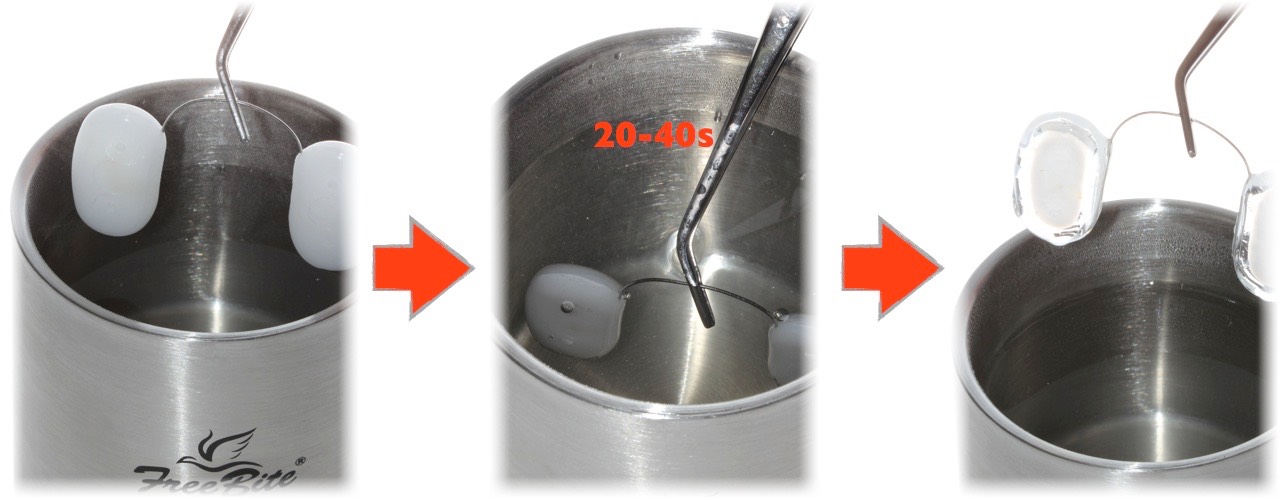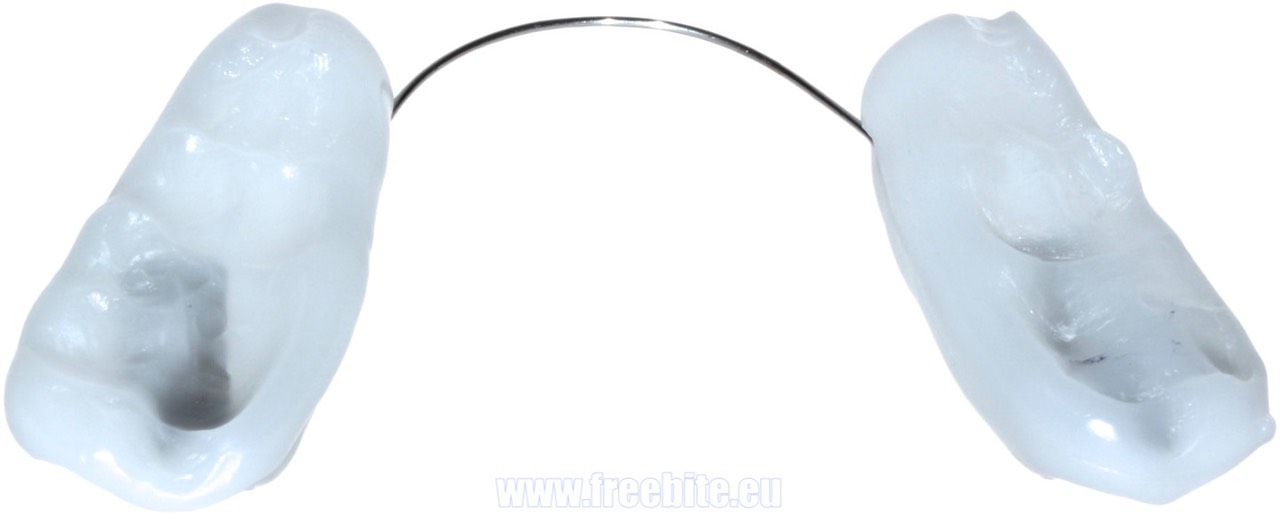Please read the general information about the FreeBite solid and about free vs. indexed bite registration techniques before proceeding to this step-by-step protocol. Since both, indexed and free registration techniques have several steps in common, they will be jointly explained here, with the additional steps for the indexed technique given in red.

- Establish a pattern and its consistency applying the methods outlined in ”Monitoring Mandibular Position“.
- Affix reference points to tips of nose and chin using a marker pen or triangles of adhesive tape and measure the distance between them in habitual occlusion. After it has been worn for a minimum of 30-60 minutes, remove the FreeBite from the mouth and measure this distance again without allowing the patient to bite into habitual occlusion. A relaxed lip seal should be present, except in chronic mouth breathers. The difference between the two measurements minus 1-2 mm freeway space is the amount by which the bite can usually be raised with a bite splint. The second measurement minus the intended freeway space is the Orthopedic Mandibular Position (OMP) at which the bite registration will be taken.
For the indexed bite registration technique, determine the appropriate FreeBite air which the patient can compress between the teeth to the OMP without having to exert excessive force.
The patient should not close into habitual occlusion after the FreeBite has been worn in preparation until the bite registration has been completed, in order to avoid compromising decompression in one of both TMJ’s and a re-establishment of unfavorable muscular patterns. - Prepare the basic shape of the FreeBite solid by first bending the middle of the connecting wire to adjust the width between the anterior edges of the plastic bite rims to the first premolars and then adjusting the bite rims to follow the mandibular dental arch.
- With the patient in an upright but unstrained head and body posture the appropriate FreeBite air is inserted between the teeth and oriented such that comfortable and symmetrical contact with the rear teeth occurs. Have the patient bite onto the FreeBite air several times to the vertical dimension of the OMP while monitoring mandibular position for consistency. Apply fast setting silicone between front teeth and have patient return his mandible to OMP.
- Heat water to boiling and pour into a FreeBite thermal cup or ceramic mug. Immerse the plastic bite rims of the FreeBite solid into the hot water for 20-40 seconds using pincers to hold it by the connecting wire. The special thermoplastic material will turn color from white to translucent as it softens. Do not overheat the material as the heat taken up will continue softening it even after removing it from the hot water. Overheated material may detach from the supporting wire making handling of the FreeBite solid needlessly difficult. Remove from hot water when the outer 2-3 mm have become translucent. It is safer to err on the side of caution and underheat the material initially, since it can easily be re-heated a second and third time. If the material should become detached from the supporting wire, it can be reattached by softening it all the way, pushing it back onto the wire and letting it cool until it is completely solidified. Alternatively, the bite rims can be used without the wire as two separate pieces - it just makes handling a bit less convenient.
- Allow hot water to drip off for 10 seconds, remove FreeBite from the mouth of the patient and insert the FreeBite solid onto the lower teeth with the connecting wire behind the mandibular incisors. Mold with slight finger pressure on buccal and lingual to the lower dental arch.
- For indexed bite registrations, replace silicon index between anterior teeth making sure that the connecting wire of the FreeBite solid does not interfere with the correct seat of the index on the incisors. Trim index accordingly if necessary. Maintaining an upright but unstrained head and body posture have the patient tap his teeth into the softened bite rims until the anterior teeth are seated in the indentations of the index. If needed, employ a second step, re-immersing the FreeBite solid into hot water for 10-20 seconds as needed to soften enough surface thickness that it can be molded to OMP.
- For free bite registrations have the patient lightly tap his teeth onto the softened bite rims while monitoring the distance between the reference points with a ruler or caliper. Opening the mouth a little more and tapping loosely while using the inertia of the mandible usually works better than squeezing the teeth into the bite rims by applying muscular force. As OMP is approached, instruct the patient to watch for the symmetry of contacts between teeth and bite rims. The thermoplastic material will set quite slowly as it cools to mouth temperature and potential premature contacts become more noticeable as the material hardens. At this stage, the patient can also slide on the bite rims by making small horizontal movements with the mandible while allowing the teeth to ride up excentric slopes in the bite record. This will make wear more comfortable for testing purposes later. Cooling and hardening the bite rims can be hastened by removing the FreeBite solid from the mouth carefully to avoid distortions and immersing it into cold water.
- Keep in mind that bite registrations usually are accomplished easier and with more precision in a few steps, rather than attempting to do it in one single step. Simply re-immerse the bite rims in hot water. This will have cooled a little by now, which, in conjunction with a shortened immersion time of a few seconds will only melt a thin surface layer of the bite rims. If more is required for subsequent corrections, extend the immersion time accordingly.
- In the end, a hard bite record should result which gives the patient a very sensitive feel of occlusal contacts, rather similar to that on teeth. The bite record can therefore be checked very accurately and optimized further if needed. Very short immersion times in hot water of 1-3 seconds ensure that only details of occlusal contacts can be changed, not the mandibular posture at large. This bite record can be worn like a bite splint for testing purposes before it serves for mounting dental casts in an articulator. During this step, the accuracy of the dental casts can be checked, as they should fit into the impressions created in the mouth without rocking. If a high enough quality of the dental cast is not attainable for some reason, the FreeBite solid can be adjusted to the dental casts by immersing it for 1-2 seconds into hot water and setting the casts into it with moderate finger pressure. However, the bite record should then be re-checked in the mouth of the patient to ensure it still fits perfectly there.


